Volkswagen e-Golf vs BMW i3
Can the new VW e-Golf put battery-powered cars on the road to mainstream success? We find out as it meets the brilliant BMW i3
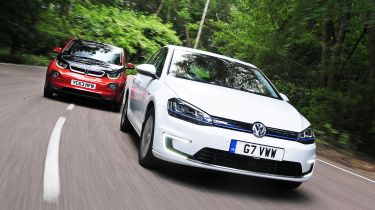
Electric cars have yet to spark a wholesale switch away from the combustion engine, but sales are rising and the launch of an electric version of Europe’s biggest-selling car is another example of the growing surge towards the mainstream.
The new VW e-Golf is available to order now and follows hot on the heels of the e-up! city car. Plus, once you factor in the Government Plug-in Car Grant, the newcomer costs £25,845 – which places it squarely in the path of BMW’s new i3.
The £25,680 i3 has already impressed us with its head-turning image, cleverly packaged interior and advanced composite structure. So if you’re ready to make the switch to electric motoring, is the cutting-edge, futuristic BMW or the electrified Golf the better choice?
Which electric car comes out on top? Read individual reviews by clicking the links above, and scroll down for a full comparison and verdict...
Head-to-head
Connectivity
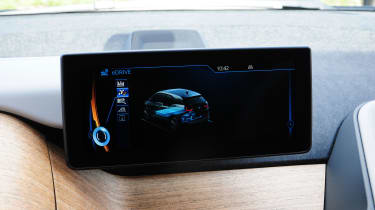
The e-Golf and i3 feature clever connectivity apps for smartphones, allowing you to check your battery and charging status remotely and also pre-heat or cool the cabin when the car is plugged into the mains.
Both cars are also available with mobile Internet options. VW’s Car-Net provides online traffic info, while if you toggle through the BMW’s display menu (below), the ConnectedDrive set-up lets you stream music and use social media.
Colours
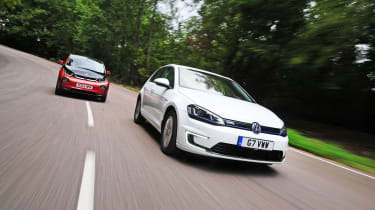
The i3 comes with the option of four £530 metallic colours with two contrasting shades for the bonnet and tailgate. Our car’s solar orange finish is the most adventurous. The e-Golf comes in a choice of six £535 metallic and two standard colours, plus our car’s £255 Pure White paint.
Dimensions
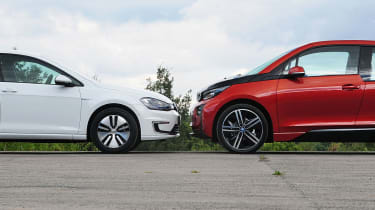
Park these cars nose-to-nose, and you can see how much taller the i3 is than the e-Golf. It’s also shorter and narrower, and that makes it well suited to city driving.
More reviews
Car group tests
In-depth reviews
Long-term tests
Road tests
The Golf’s traditional shape attracts much less attention on the road, but gives you a bigger boot and more passenger space.
Verdict
1st place: BMW i3
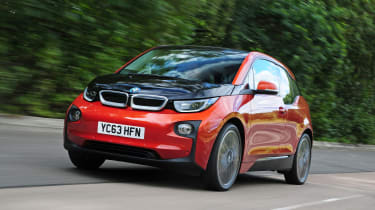
With innovative engineering and the use of advanced composite materials, the i3 is a groundbreaking electric car that’s fast, good to drive and practical. But beyond the technology, the funky cabin and futuristic looks give it the desirability factor EVs have traditionally lacked. If you can cope with the range limitations, then it’s a very tempting proposition. And it just edges victory over the worthy but less exciting VW.
2nd place: Volkswagen e-Golf

The e-Golf is another excellent electric car from Volkswagen. It’s a well engineered and good-to-drive EV, with a similar real-world range to the i3. The Golf won’t turn as many heads as the i3, but its traditional image is a plus for some. However, it trails the BMW on performance, plus the ride is firm and the handling slightly blunted. More importantly, it lacks the all-round desirability of its futuristic rival.
VW e-Golf vs BMW i3: key specs
| BMW i3 | Volkswagen e-Golf | |
| On the road price/total as tested | £25,680/£25,680 | £25,845/£27,090 |
| Residual value (after 3yrs/36,000) | £7,730/30.1% | £7,469/28.9% |
| Depreciation | £17,950 | £18,376 |
| Annual tax liability std/higher rate | N/A | N/A |
| Ins. group/quote/road tax band/cost | 21/£332/A/£0 | 10/TBC/A/£0 |
| Servicing costs | £375 (5yrs/60k) | £384 (3yrs/30k) |
| Length/wheelbase | 3,999/2,570mm | 4,349/2,637mm |
| Height/width | 1,578/1,775mm | 1,452/1,799mm |
| Engine | AC electric motor | AC electric motor |
| Peak power | 168bhp | 113bhp |
| Peak torque | 250Nm | 270Nm |
| Transmission | Single speed/rwd | Single speed/fwd |
| Battery warranty (miles)/spare wheel | 8yrs (100k)/sealant | 8yrs (99,360)/sealant |
| Boot capacity (seats up/down) | 260/1,100 litres | 341/1,231 litres |
| Kerbweight/payload | 1,270/425kg | 1,510/450kg |
| Turning circle/drag coefficient | 9.9 metres/0.29Cd | 10.0 metres/0.28Cd |
| Basic warranty (miles)/recovery | 3yrs (unltd)/3yrs | 3yrs (60,000)/3yrs |
| Service intervals/UK dealers | Variable/47 | 10,000/24 |
| Driver Power manufacturer/dealer pos. | 10th/22nd | 19th/31st |
| Euro NCAP: Adult/child/ped./stars | 86/81/57/4 | 94/89/65/5* |
| 0-60/30-70mph | 7.1/6.5 secs | 9.6/10.2 secs |
| 30-50mph | 2.3 secs | 3.8 secs |
| 50-70mph | 4.2 secs | 6.4 secs |
| Top speed | 93mph | 87mph |
| Braking 70-0/60-0/30-0mph | 49.5/38.1/8.7m | 57.9/36.6/10.2m |
| Claimed range | 120 miles | 118 miles |
| Full charge time (mains) | 13 hours (est) | 13 hours (est) |
| 80 per cent charge time (fast charger) | 30 minutes (est) | 35 minutes (est) |
| Actual/claimed CO2/tax bracket | N/A | N/A |
| Airbags/park sensors/reversing cam | Six/yes/£790 | Seven/yes/£165 |
| Leather/heated seats/climate control | £2,000/£260/yes | £2,095/£375/yes |
| Met paint/LED lights/cruise control | £530/£710/yes | £535/yes/yes |
| Split/fold rear seats/Isofix | Yes/yes | Yes/yes |
| Sat-nav/DAB radio/Bluetooth | Yes/yes/yes | Yes/yes/yes |


